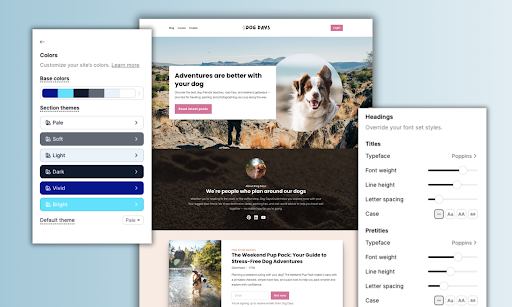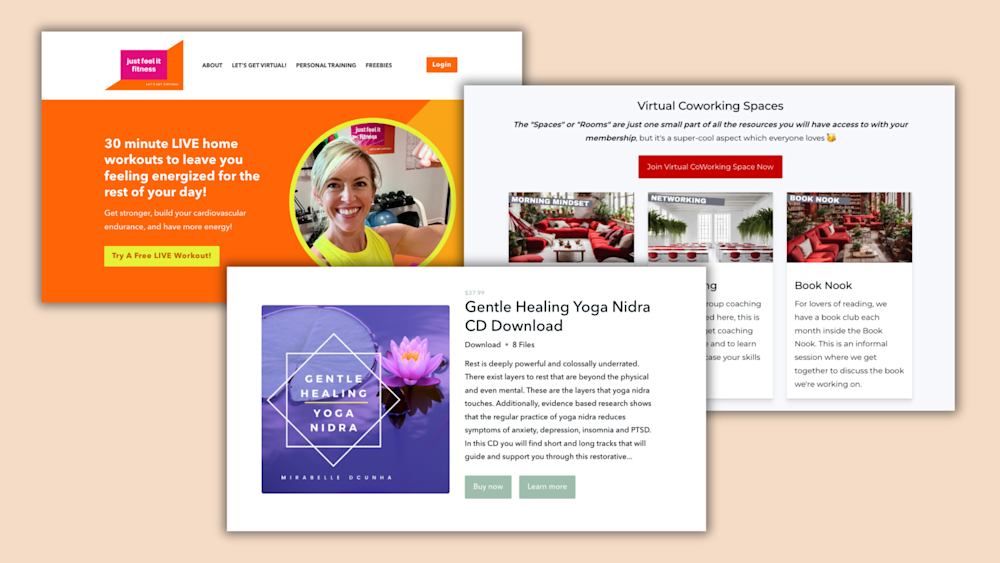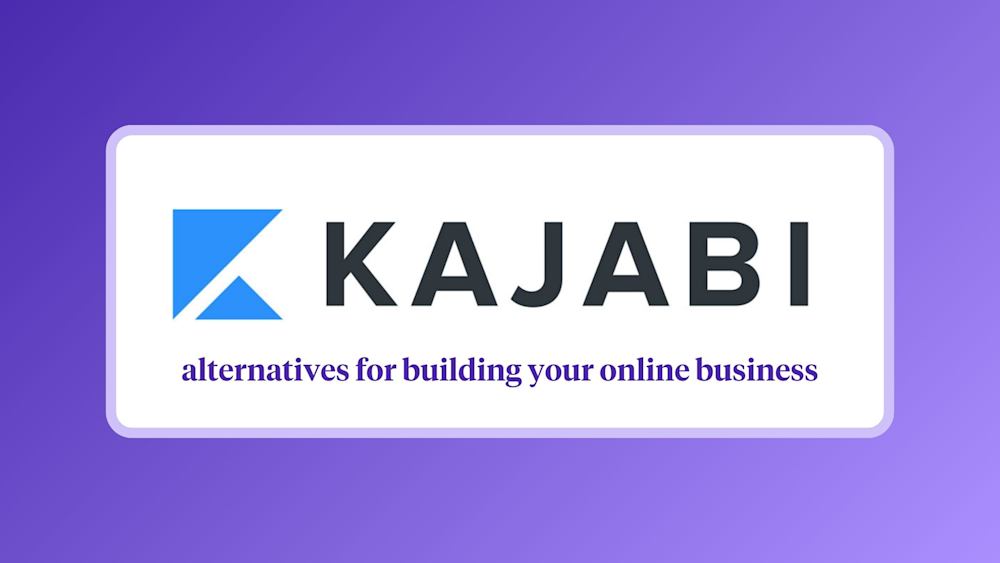Whether you’re a new creator or a seasoned pro, there’s a good chance your business needs a website. Entrepreneurs already wear many hats, so it’s important to find a website builder that’s easy to use and headache-free.
Squarespace is a popular option because you can design and build a website without knowing how to code. Squarespace provides a variety of website templates, and you can also set up an online store, highlight your work in a digital portfolio, or start a blog.
But Squarespace has some limitations, and it isn’t the right fit for everyone. In this article, we’ll cover the pros and cons of this popular website building platform, as well as seven Squarespace alternatives to consider if it doesn’t suit your needs.
Squarespace pros and cons
First, let’s look at some benefits and shortcomings of Squarespace.

Squarespace pros
Website templates: When you build a website with Squarespace, you’ll get access to several templates to jumpstart your site design.Squarespace offers specialized themes for portfolio websites, ecommerce shops, blogs, service-based businesses, and other use cases. You can also buy third-party templates if you want a different look.
Ecommerce tools: If you’d like to sell products and services from your website, Squarespace has three plans with ecommerce functionality.You can also accept bookings and appointments through Squarespace’s scheduling tool, available for an additional fee.
Membership area: For an additional cost, you can use Squarespace to build a membership area for your brand. Members can enjoy exclusive files, videos, premium content, and virtual events. Your membership area can be free or paid, and you can add unlimited members.
Email marketing tools: Want to stay in touch with your audience? Squarespace has an email marketing add-on with email design layouts to make your messages feel cohesive with your website. This feature is available for an extra fee.
Squarespace cons
Difficult to use: Squarespace markets itself as easy, but many users find that the site editor is harder to use than expected. Some settings and elements can only be adjusted on individual pages and others must be tweaked in the Site Styles area, which is located in a different section of your Squarespace dashboard.
For example, here are the steps you’d need to take to restyle a button on your home page:
-
On the Squarespace home screen, click “Pages” and select your home page.
-
Select the “Edit” button in the top left corner.
-
Click the pencil icon next to the button you’d like to change.
-
Change the button text, link destination, button size, and alignment, then click “Done”.
-
Return to the Squarespace home screen and click “Design”.
-
Select the “Site Styles” tab.
-
Click “Buttons” to change the style, shape, and padding.
-
Select “Colors” to change the color palette across your site.
-
Select “Fonts” and scroll down to the “Buttons” section to change settings like font family, text weight, letter spacing, and text transform for all buttons across your site.
That’s a lot of steps just to tweak one button. When you’re new to Squarespace, navigating between pages, elements, and style settings can be confusing and time-consuming.
Limited customizations: While templates offer a nice starting point, many users feel that the customization options are too narrow with Squarespace. The website builder is simple for non-developers, but the catch is that you can only edit certain aspects of your site.
The core blocks that make up most theme designs are rigid, and making changes beyond what’s offered in the style editor requires some coding knowledge. You’ll be fine if you need to swap out text, pictures, and colors, but changing fine details gets tricky.
Not ideal for selling digital products: While it’s possible to sell digital products on Squarespace, the ecommerce tools and extensions are mainly geared toward selling physical products. The maximum file size you can sell is 300MB.
You can only offer one file per digital product listing, but you can zip files together if the total stays under 300MB. You can’t offer variations for digital items, nor can you sell digital products as subscriptions.
Complicated pricing structure: If you’d like to use some of Squarespace’s advanced features like email marketing, memberships, or scheduling, you’ll need to pay extra fees each month. Here’s a look at the Squarespace pricing plans and add-ons:
Squarespace pricing:
-
Personal: $19/month
-
Website builder
-
Templates
-
Unlimited bandwidth
-
-
Business: $33/month
-
Marketing tools
-
Customizations through CSS and Javascript
-
Integrated ecommerce (3% transaction fee)
-
-
Basic Commerce: $36/month
-
No transaction fees
-
Customer accounts
-
Ecommerce analytics
-
-
Advanced Commerce: $65/month
-
Abandoned cart recovery
-
Subscriptions
-
Advanced shipping and discounts
-
Squarespace membership area pricing (add-on):
-
Starter: $10/month (+7% transaction fee)
-
5 hours of video storage
-
1 member area
-
-
Core: $20/month (+4% transaction fee)
-
20 hours of video storage
-
3 member areas
-
-
Pro: $40/month (+1% transaction fee)
-
50 hours of video storage
-
10 member areas
-
Squarespace email pricing (add-on):
-
Starter: $7/month
-
3 campaigns per month
-
500 emails per month
-
-
Core: $14/month
-
5 campaigns per month
-
5,000 emails per month
-
Automations
-
-
Pro: $34/month
-
20 campaigns per month
-
50,000 emails per month
-
-
Max: $68/month
-
Unlimited campaigns
-
250,000 emails per month
-
Squarespace scheduling pricing (add-on):
-
Emerging: $15/month
-
Growing: $25/month
-
Powerhouse: $50/month
Here’s how this could play out by the numbers:
Suppose you wanted to build a website with ecommerce functionality, a membership area, and email marketing. You’d pay $33 per month for the core Business plan, $10 per month for the Starter membership plan, and $7 per month for the Starter email plan.
Your total would be $50 per month plus transaction fees, just for the introductory offerings in each category. Simply put, Squarespace’s pricing structure is complex, and you may end up with a hefty price tag to get everything you want.
Up next, we’ll explore seven Squarespace alternatives that might fit the bill instead.
7 best Squarespace alternatives
1. Podia
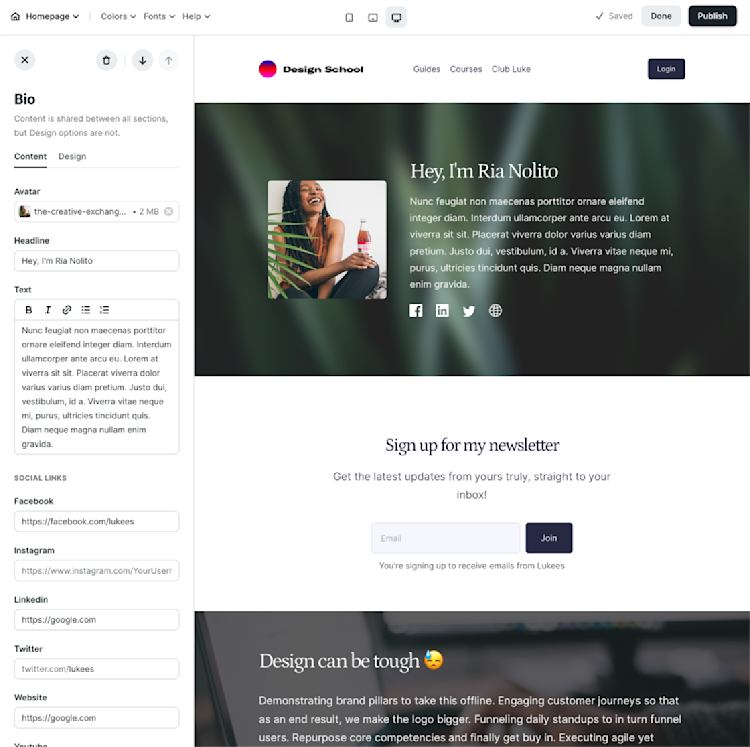
Podia is an all-in-one platform for running your business where you can create a stylish website in no time.
Podia’s website builder gets top marks for ease of use, and you don’t have to know code to make your site look amazing. You can make as many web pages as you need and even create standalone sales pages and landing pages to promote your offerings.
There are over a dozen different website sections to choose from, and within each section, you can customize the content (like title, description, button text, and what content to include) and the design (like orientation, layout, style, color, and background image).
You can style each content block with just a few clicks to get a totally different look and layout.

But don’t just take our word for it. According to Podia creator and Flex Lessons founder Joseph D’Amico, “Podia makes website building so fun. I feel like I could set up a site in an afternoon, and it would look great. And there’s something to be said for how pretty it is. It’s the best-looking one by far.”
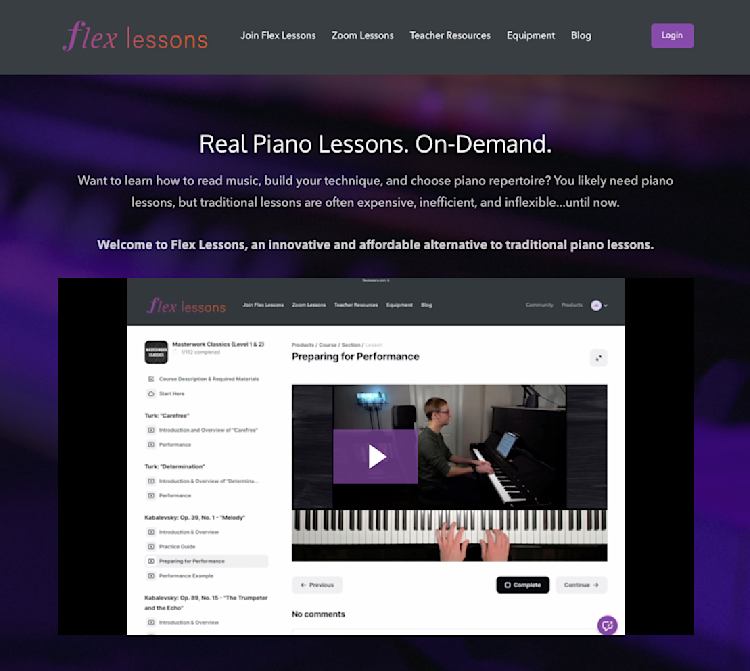
The cherry on top? Podia’s plans come with a complete website, unlimited landing pages, blogging, online courses, webinars, and unlimited digital downloads and coaching products. Essentially, you can build a powerful and profitable online presence all from your Podia dashboard.
Bottom line: With Podia, you can build a fantastic website, sell your work, and run your entire business for a fraction of the price of Squarespace.
Podia features:
-
Complete website builder with unlimited pages (including sales pages and landing pages)
-
Sell unlimited courses, digital downloads, webinars, and coaching/services
-
Built-in email marketing, affiliate marketing, and customer messaging
-
Unlimited bandwidth (content and video)
-
Podia hosts your website for you
-
Top-notch customer support
-
Mover: $39/month or $33/month when paid annually (5% transaction fee)
-
Shaker: $89/month or $75/month when paid annually
Get started today with a free 30-day trial, and check out our video demo to see these features in action.
2. Shopify
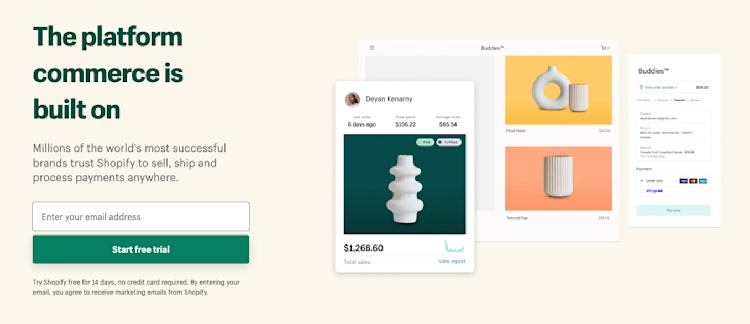
Shopify is a popular ecommerce platform for selling physical products online. With Shopify, you can build an entire website or online storefront to showcase your creations.
To start, pick a theme that matches your brand. There are dozens of templates to choose from that are organized by business type and industry. Customize your site using Shopify’s drag and drop editor to make your page just right.
From there, you can add products and sell online, in-person, or through your social media channels. Shopify can help you track your finances, fulfill orders, handle shipping, manage inventory, issue refunds, and learn about your business through analytics.
Shopify features:
-
Full website on Basic plans and above
-
Website templates
-
Sell products online or in-person through Shopify’s point of sale system
-
Tools for managing logistics
-
Built-in Shopify payment processor
Shopify benefits: Shopify comes with free and paid themes you can use to customize your website. For those offering physical products, Shopify provides a suite of tools to make the selling process a breeze. If you want to keep in touch with your customers, Shopify email is available on all plans. The first 10,000 emails each month are free, and after that, you’ll pay $1 per $1,000 additional emails sent.
Shopify downsides: Shopify is best suited for people selling physical products. If you just need a website for your brand or blog, Shopify isn’t the best fit. It’s also not the best choice for creators selling digital products like courses, ebooks, memberships, and brand communities. Additionally, Shopify has a complex pricing structure with transaction fees on all plans unless you use their payment gateway.
Shopify pricing:
-
Shopify Lite: $9/month
-
Basic: $29/month, online credit card rate: 2.9% + $0.30, transaction fee if not using Shopify payments: 2%
-
Shopify: $49/month, online credit card rate: 2.6% + $0.30, transaction fee if not using Shopify payments: 1%
-
Advanced: $299/month, online credit card rate: 2.4% + $0.30, transaction fee if not using Shopify payments: 0.5%
-
Shopify Plus: Custom plans starting at $2000/month
3. WordPress

WordPress is free, open-source website-building software that’s popular among bloggers and business owners alike. There are two ways you can use WordPress to build your website:
Self-hosted WordPress: With a self-hosted WordPress site, you’ll purchase a domain, sign up for website hosting, and install WordPress yourself. Check out this article to learn more about signing up for website hosting.
From there, you can add your favorite themes, tools, and plugins to make your website function the way you need. Because WordPress is a content management system (CMS), it’s a good choice for creators and bloggers who share lots of content with their followers.
Managed WordPress website: Your second option is to build your website with WordPress for managed hosting. They’ll handle your hosting, so you don’t have to choose a third-party provider.
WordPress offers two plans: WordPress Free and WordPress Pro.
You can set up a simple website with 1GB of storage on the free version, but you cannot connect custom domains, install plugins, or monetize your site through ads or product sales. Additionally, WordPress will display its own ads on your free website, and you can’t disable this unless you upgrade to the Pro plan.
With the WordPress Pro plan, you can connect your own domain, install plugins, use premium themes, sell your own products, and earn money from advertising if you choose to do so. You’ll get 50GB of storage and access to behind-the-scenes parts of your website for greater customization. WordPress Pro hosted on WordPress.com costs $15 per month.
WordPress features:
-
Free, open-source site builder software
-
Self-hosted: You install WordPress yourself and pay for your domain and website hosting separately
-
WordPress.com hosting: Choose between the limited Free plan or the $15 per month Pro plan
-
Search engine optimization (SEO) tools to help your content rank
-
Ideal for website developers and creators with coding knowledge who want lots of customization options
WordPress benefits: The biggest plus of using WordPress is how customizable it is. There are over 50,000 free and paid plugins you can use for maximum functionality, and there are seemingly endless themes to give your site a unique look and feel. Because WordPress is popular, it’s easy to find third-party resources, tutorials, and videos to help you learn the platform.
WordPress downsides: On the flip side, WordPress has a steep learning curve. You may need to hire a web developer to get everything set up, and you’ll be responsible for keeping everything updated and working correctly.
WordPress is not an all-in-one solution. You’ll need to use a separate service or plugin for managing email, selling courses, creating memberships, and running your affiliate program.
Finally, even though the base software is free, you’ll need to pay for hosting, your domain, and other tools to get your website up and running. Depending on your needs, this could cost more than an all-in-one platform.
Managed WordPress.com pricing:
-
WordPress Free
-
WordPress Pro: $15 per month
Self-hosted WordPress pricing:
-
The WordPress software is free and open-source
-
You’ll pay for web hosting, domain registration, and any premium themes or plugins that you want to use
4. Wix

With Wix, you can create a storefront, blog, or business website using a drag-and-drop page builder. Set up your site quickly with modern templates and upgrade as needed to unlock more features.
Like Shopify, Wix comes with handy tools for selling physical products. Sell print-on-demand and dropship products, subscriptions, and even gift cards for your online store.
Business plans include online booking functionality, event and ticket management, and special tools for hotel owners, restaurants, and fitness professionals.
Wix also offers a limited free plan if you only need a simple site. Free plans have prominent Wix branding that can only be removed by upgrading to one of their premium plans.
Wix features:
-
Drag and drop editor and website builder
-
800+ templates, including blank templates if you want to build from scratch
-
Ecommerce store for selling products and services
-
Sell digital products like files, PDFs, images, audio, and videos
-
24/7 customer care on all plans
-
Wix Artificial Design Intelligence (ADI)
-
For developers: Velo by Wix is a development platform where you can build web applications
Wix benefits: Wix’s drag and drop website builder is intuitive, even if you’re not tech-savvy. You can also get help from Wix’s unique Artificial Design Intelligence (ADI) tool, which uses artificial intelligence to design a custom site for your brand.
If you sell physical products, there are native ecommerce integrations for drop shipping, gathering customer reviews, and running loyalty programs on higher-tier business plans. You can also send automated abandoned cart emails on all business plans.
Wix downsides: On the Free plan, you cannot remove loud Wix branding from your site. To disable Wix ads, you’ll need to be on the Combo plan ($16 per month) or higher. Wix also limits website storage space on all plans. This could be a problem for creators like videographers and photographers who want to showcase their work.
Wix website plans:
-
Free plan (with Wix branding)
-
Combo: $16/month
-
Unlimited: $22/month
-
Pro: $27/month
-
VIP: $45/month
Wix business plans:
-
Business Basic: $27/month
-
Business Unlimited: $32/month
-
Business VIP: $59/month
5. Webflow
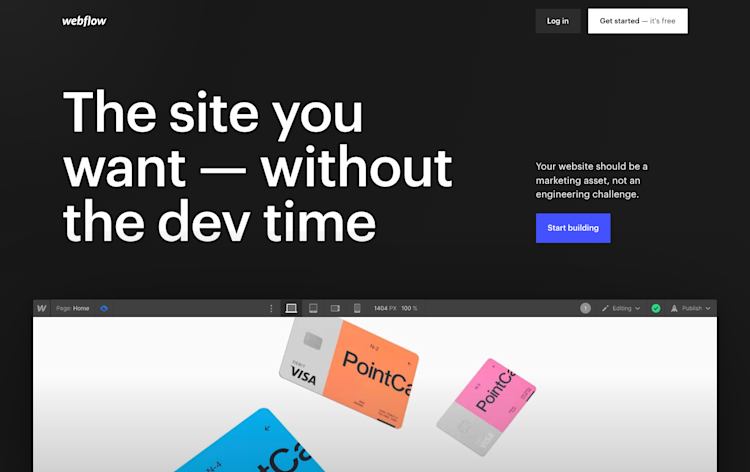
Webflow is a code-free website builder, ecommerce platform, and content management system. Webflow has powerful website design features for makers who want to start with a blank slate, but there are over 100 templates available if you need some guidance. You can even add interactive webpage elements and animations.
Through Webflow’s ecommerce tools, you can sell physical products, digital products, and services. Display unique product fields to highlight the most important information for buyers and create a customized checkout process–even if you don’t know how to code.
Webflow features:
-
No coding required
-
Ecommerce tools for selling products and services
-
Content management system
-
Interactive features like movement, animations, and scroll progress
-
Native SEO tools
-
Flexible templates (unlike Squarespace, where the templates are more rigid)
-
Backend website hosting through AWS
Webflow benefits: Webflow has a Free plan where you can build your own website, add up to 50 CMS items, and use up to 1GB of bandwidth. There are paid CMS plans, ecommerce plans, and workplace plans with different attributes so you can choose the best option for your needs.
If you sell products, your customers can pay through Stripe, PayPal, Apple Pay, or Google Pay.
Webflow downsides: Because Webflow offers so much flexibility, it could be overwhelming for someone who just wants to set up a simple website for their business. Having unlimited customization options isn’t always better.
Additionally, there are limits on bandwidth, number of CMS items, number of products, annual sales volume, monthly visitors, and number of website pages on almost all plans.
For example, Webflow’s $42/month Standard ecommerce plan has a limit of 500 items and a cap of 50K annual sales volume.
The $84/month Plus ecommerce plan has a limit of 1,000 items and 200K annual sales volume.
The $235/month Advanced plan doesn’t have an annual sales volume limit, but you’re still limited to 3,000 items.
Webflow website pricing:
-
Starter: Free
-
Basic: $15/month
-
CMS: $20/month
-
Business: $45/month
Webflow ecommerce pricing:
-
Standard: $42/month
-
Plus: $84/month
-
Advanced: $235/month
6. Weebly
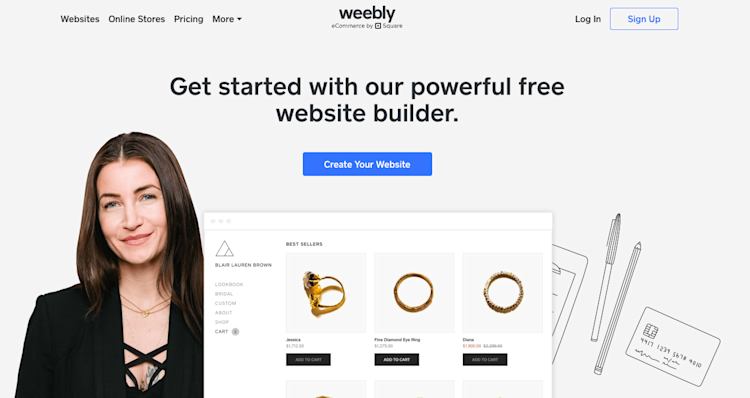
Weebly is an ecommerce platform and website builder owned by Square. With Weebly, you can choose from customizable templates and use their drag and drop builder to make your site shine.
Weebly has blogging tools for sharing content, an App Center for adding extra functionality, and analytics so you can track how your site is performing.
On the ecommerce front, Weebly includes shipping resources, inventory management features, gift cards, customer reviews, and an automatic tax calculator.
Weebly features:
-
Drag and drop website builder
-
Add custom CSS, HTML, and code
-
Hosting included
-
Buy your domain directly through Weebly
-
Community, chat, email, and phone support
-
App Center for connecting additional extensions and integrations
Weebly benefits: The Weebly website builder is user-friendly and suitable for beginners who don’t have extensive website experience. If you plan to sell products, Weebly offers many of the same ecommerce features as Squarespace for a lower cost.
All plans, including the free plan, come with a shopping cart, unlimited products, inventory management, item options, item badges, and coupons. Weebly also provides users with tools to edit images directly in Weebly, saving you a step in your workflow.
Weebly downsides: On Weebly’s Free plan, there are storage limitations, and you can’t sell digital products. Weebly will also display Square ads on Free and Personal plans, so you’ll need to upgrade to Professional or Performance to remove these.
Weebly pricing:
-
Free
-
Personal: $9/month
-
Professional: $16/month
-
Performance: $29/month
7. Duda
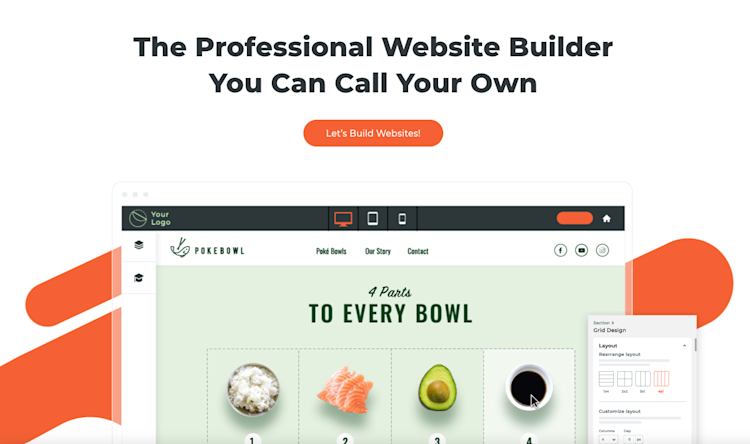
With Duda, you can create modern websites for yourself or clients. The page editor is straightforward, and Duda comes with a wide selection of elements for customizing your site. If you hope to use Duda for ecommerce, you won’t be disappointed. There are no transaction fees, you can accept 40 different payment methods, and you can sell subscriptions on the Advanced and Unlimited plans.
One thing that sets Duda apart from other popular website builders is that it includes client management and collaboration tools for professional web designers and agencies. You can see all your projects in one place and quickly build, maintain, and deploy Duda websites for your customers in just a few clicks.
Duda features:
-
Lots of templates
-
Edit the mobile version and desktop version of your site separately for different looks
-
Create a membership area
-
Get more functionality using the Duda App market
-
Create your own widgets and automation rules
Duda benefits: With Duda, you can build websites for your own business or for your clients, all under one roof. Start with one of their templates or create a unique design from scratch. You can also make reusable website sections to use across multiple pages and projects.
Duda downsides: Duda doesn’t offer a free plan, and the paid plans can be pricey. If you use Duda for ecommerce, the Standard and Advanced add-ons limit the number of products you can sell. Also, there are no newsletter or email marketing tools built-in, so you’ll need to integrate with another platform to get this functionality.
Duda pricing:
-
Basic: $19/month
-
Team: $29/month
-
Agency: $59/month
-
Custom
Add on ecommerce pricing:
-
Standard: $8/month (100 products)
-
Advanced: $22/month (2500 products)
-
Unlimited: $49/month (unlimited products)
Which alternative to Squarespace is right for me?
Best all-in-one alternative to Squarespace:
-
Podia: Podia comes with your website, landing pages, blog, digital products, email marketing, and affiliates all in one tool so everything is automatically connected from day one. You can build a great website and launch your online business at the same time, and Podia has a 30-day free trial where you can test everything out.
Best Squarespace alternatives for selling physical products:
-
Shopify: They provide tools to help fulfill orders, ship products, manage inventory, issue refunds, and track finances.
-
Wix: You can print on demand, dropship products, manage inventory, and ship your items.
Best alternatives to Squarespace for selling digital products:
-
Podia: Sell online courses, digital downloads, webinars, and coaching in addition to running your website.
-
WordPress: Third-party apps and plugins make it possible to sell digital products and create a community. These tools usually come with an extra cost.
Best Squarespace alternatives for bloggers:
-
Podia: Podia includes a full blogging feature with unlimited posts
-
WordPress: This is an open-source content management system that can be customized to meet your blogging needs.
-
Webflow: This content management system comes with SEO features and hosting.
Best platforms for running a web design business or agency:
-
Duda: Collaborate with customers, send previews, and design custom reusable elements.
-
Webflow: Build and manage website projects, collaborate with team members, and bill clients through the Webflow dashboard.
Best all-in-one alternative to Squarespace: Podia
With Podia, you can create a full website. It’s the best website builder for creators who want customization without the overwhelm, and for anyone who dreams of building a virtual home base for their entire creative business.
Design a beautiful website, sell your work, and share your story. At Podia, we’ll help you make it happen, and we can’t wait to see what you create.
Get your free 30-day trial from Podia and start building your website today.

